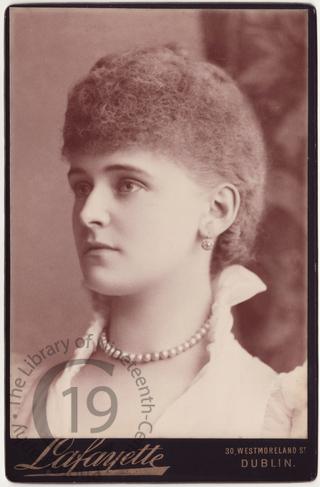
Daisy, Countess of Warwick
Lady Brooke, formerly Frances Evelyn Maynard, later Countess of Warwick, occupied a place in the Prince of Wales’s affections, chronologically at least, between Lillie Langtry and Mrs Alice Keppel.
Daisy (as she was known) and her husband Lord Brooke (the heir of Lord Warwick) first entered the Prince’s circle in 1886. She was the 26-year-old heiress of her grandfather, the last Lord Maynard, and one of the most beautiful and interesting women of the age. The Prince quickly became infatuated with her.
He was not, however, the first man to have fallen under her spell, and she had previously been indiscreet enough to write a letter of reproach to one of her former admirers, Lord Charles Beresford, when he had returned to his wife and this letter had accidentally fallen into the hands of Lady Beresford. Lady Brooke appealed to the Prince of Wales to help her retrieve it, and Bertie attempted to use his influence to interfere in what was, essentially, a private matter. When Lady Beresford refused to hand over the compromising letter, the Prince showed his disapproval and resentment by ceasing to invite Lady Beresford to parties at Marlborough House. Beresford blamed the Prince for the ensuing social boycott of his wife; at one interview he called the future King of England a blackguard and a coward and very nearly struck him with his fist.
When Beresford threatened to go public with the scandal in 1891 the Prime Minister, Lord Salisbury, was forced to intervene and a settlement was finally reached, based upon a formal exchange of letters (drafted by Lord Salisbury) and the temporary exclusion of Lady Brooke from court. Lady Beresford returned Lady Brooke’s letter and Lord Beresford got a written apology (of sorts) from the Prince.
Rumours of the unhappy business had reached the Princess of Wales, who was holidaying with her parents in Denmark. Rather than returning to England on 13 October 1891 as expected, she decided instead to go to Russia to visit her sister, the Empress, in the Crimea, without saying when she would come home. She remained at Livadia for the Silver Wedding celebrations of the Emperor and Empress, leaving the Prince of Wales to explain as best he could her absence at his fiftieth birthday celebrations on 9 November 1891.
Daisy Brooke was also involved in the Tranby Croft scandal, sometimes called the Royal Baccarat Scandal, of 1890-91. It was widely believed that it was through her inability to guard her tongue that the story of what had gone on at Tranby Croft became public knowledge, earning her the nickname 'The Babbling Brooke'.
Photographed by Lafayette of Dublin.
Code: 122441




